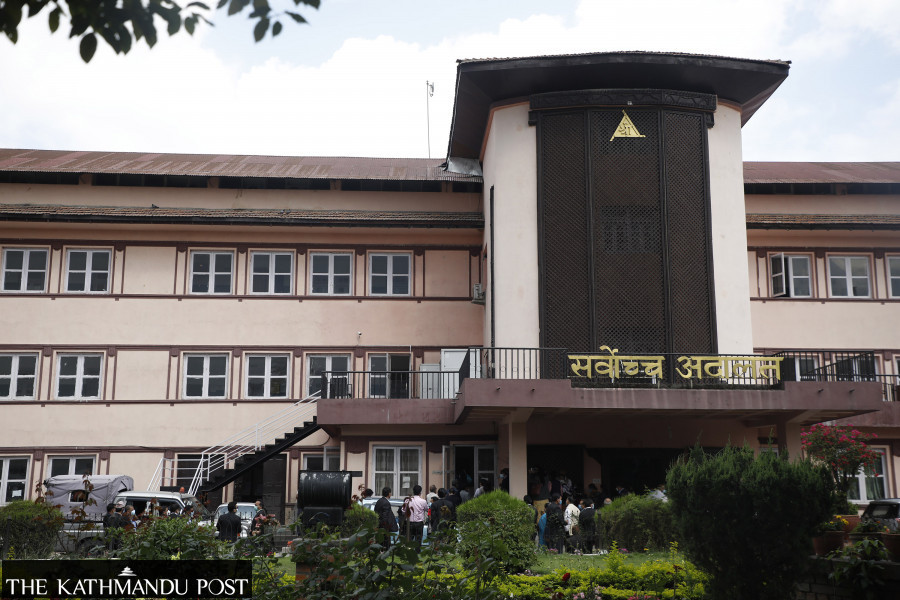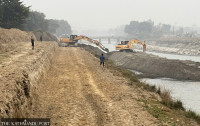National
Top court in the dock as the Constitutional Bench issue gets even more complicated
Chief justice last month decided to recuse from hearing, but benches set by him have created more confusion.
Binod Ghimire
When the drafters of Nepal’s constitution deliberated on the provisions of the Constitutional Bench, never in their wildest dreams did they possibly imagine a situation resulting in a deadlock in the Supreme Court.
Questions over the Constitutional Bench were raised first when erstwhile prime minister KP Sharma Oli dissolved the House of Representatives in December last year. The issue was prominently discussed after Oli dissolved the House again in May this year. As a result, Chief Justice Cholendra Shumsher Rana was forced to constitute the bench with justices at the Supreme Court on the basis of their seniority. He led the bench.
The situation became even more complicated when questions arose over whether Rana should lead the bench while hearing cases if they constituted a conflict of interest.
Now, the issue has ignited a tussle between the bar and the bench.
On September 2, a single bench of Justice Hari Phuyal issued an interim order, observing that there was a need to finalise whether the bench can sit without the chief justice. He also asked the Nepal Bar Association and Supreme Court Bar to send two senior advocates as amici curiae.
A hearing to settle the issue was scheduled for Friday. But the two entities of the lawyers’ representatives refused to send the names. The hearing was expected to give a way out on whether the chief justice’s presence is mandatory in the Constitutional Bench.
Further confusion arose after Chief Justice Rana constituted a divisional bench of Justices Prakash Dhungana and Manoj Sharma, which could not make a decision except asking both the bars to send two advocates each as amici curiae.
“In a high-level meeting between the bench and the bar last week, there was an agreement that the issue needed serious constitutional interpretation. Therefore, we said it needed to be dealt with by the Constitutional Bench,” Purna Man Shakya, chairperson of the Supreme Court Bar, told the Post. “However, to our utter dismay, a division bench was formed on Friday.”
Chief Justice Rana on August 27 decided to rescue himself from the Constitutional Bench that was scheduled to hear petitions challenging the appointments of chairpersons and members to different constitutional bodies. He agreed to take leave, allowing the senior most justice, Deepak Kumar Karki, to lead the bench.
Rana’s decision was supposed to help expedite the cases, as they had been pending for months.
Since Rana, as per the constitutional provisions, is a member of the Constitutional Council, which made the recommendations, the Constitutional Bench led by him would have constituted a conflict of interest, some argued.
But Article 137 (1) of the constitution envisions a Constitutional Bench led by the chief justice. Rana’s decision to recuse himself from the hearing was challenged in the court. Accordingly, Justice Phuyal asked whether the Constitutional Bench could sit without him.
Advocates who have filed the petitions say Friday's incident has created uncertainty.
“The ruling by Phuyal’s bench complicated the hearing process,” Om Prakash Aryal, one of the advocates who have challenged the constitutional appointments, told the Post. “The court should give a solution rather than complicating the matter.”
On December 15 last year, the Oli government introduced an ordinance to amend the Constitutional Council Act-2010 to ease convening the Council’s meeting. Before the amendment, Clause 6 (3) of the Act said that “at least five members must be present besides the prime minister for the Council to convene its meeting”.
The amendment to the provision meant the Council could convene a meeting when the majority of existing members were present. With no deputy Speaker appointed, Oli held the meeting in the presence of the chief justice and the National Assembly chair. The Council’s meeting on the same day recommended 38 chairs and members to be appointed to the different commissions. Of them, 32 got appointments without a parliamentary hearing as the House of Representatives was dissolved. Aryal challenged the decision the very next day.
Despite criticism, and petitions under consideration at the Supreme Court, the Council made 20 more recommendations in May. They were automatically appointed, once again, without a parliamentary hearing after 45 days, as the House was dissolved by Oli for the second time then. At least four other writ petitions were filed against the Council's recommendations.
Now the hearing on cases against constitutional appointments has been thrown into limbo as there is confusion over whether the chief justice should lead the bench, an issue which has further been complicated after the Nepal Bar Association and the Supreme Court Bar Association refused to send their representatives.
“It’s a judge’s right to rescue himself/herself from any hearing,” senior advocate Dinesh Tripathi, who specialises on constitutional law, told the Post. “It is sad that the hearing process that was set to commence in the absence of the chief justice has been deferred.”
Officials at Nepal Bar Association say the court’s Friday move to backtrack on the agreement to form a Constitutional Bench has raised suspicions if there are attempts to further delay the hearing on the petitions challenging appointments to constitutional bodies.
“Forming a division bench while there was an agreement to constitute a Constitutional Bench is the result of a wrong intention,” said an office bearer at the Nepal Bar Association who did not wish to be named.
Shakya, the chair of the Supreme Court Bar, said they will hold a meeting with senior advocates to decide on the next move.
“We haven't yet decided whether or not to participate in the next hearing if the Constitutional Bench is not formed,” said Shakya. “We will make a proper decision after consultations.”




 9.12°C Kathmandu
9.12°C Kathmandu















